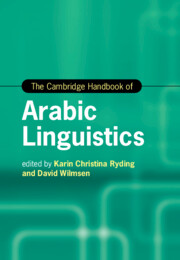Book contents
- The Cambridge Handbook of Arabic Linguistics
- Cambridge Handbooks in Language and Linguistics
- The Cambridge Handbook of Arabic Linguistics
- Copyright page
- Contents
- Figures
- Tables
- Notes on Contributors
- Acknowledgements
- Abbreviations
- Introduction
- Part I Arabic Applied Linguistics
- Part II Arabic Variation and Sociolinguistics
- Part III Theoretical and Descriptive Studies
- Part IV Arabic Computational and Corpus Linguistics
- Part V Arabic Linguistics and New Media Studies
- 21 Language Policy and the Arabic Localization of Twitter
- 22 Variation and Social Change on Syrian Dissidents’ Social Media
- Part VI Arabic Linguistics in Literature and Translation
- Index
- References
22 - Variation and Social Change on Syrian Dissidents’ Social Media
A Sociopolitical Approach to a Digital Sociolinguistics of Arabic
from Part V - Arabic Linguistics and New Media Studies
Published online by Cambridge University Press: 23 September 2021
- The Cambridge Handbook of Arabic Linguistics
- Cambridge Handbooks in Language and Linguistics
- The Cambridge Handbook of Arabic Linguistics
- Copyright page
- Contents
- Figures
- Tables
- Notes on Contributors
- Acknowledgements
- Abbreviations
- Introduction
- Part I Arabic Applied Linguistics
- Part II Arabic Variation and Sociolinguistics
- Part III Theoretical and Descriptive Studies
- Part IV Arabic Computational and Corpus Linguistics
- Part V Arabic Linguistics and New Media Studies
- 21 Language Policy and the Arabic Localization of Twitter
- 22 Variation and Social Change on Syrian Dissidents’ Social Media
- Part VI Arabic Linguistics in Literature and Translation
- Index
- References
Summary
Taking on a contemporary topic of pervasive importance, Francesco Sinatora examines in detail linguistic heterogeneity and identity construction as they impact Arabic Facebook and YouTube discourse. Key issues of identity, positioning, performance, and multimodality are embedded in Arabic speakers’ use of discourse strategies that convey meaning in multiple ways and on multiple levels. ‘Social media’, states Sinatora, ‘provides a platform for the emergence of more hybrid practices, including the mixing of the vernaculars with MSA, as well as the localization of multilingual forms and global pop culture references.’ Sinatora reviews concepts of intertextuality and indexicality as they pertain to the use of language both written and spoken in Arabic-based social media. He connects these concepts to the idea of ‘vernacular globalization’, which refers to the linguistic construction of identities through diverse and multimodal formulation of powerful and appealing text messages. The second part of his paper documents how dissent is expressed through close examination of postings on Facebook and on YouTube. Through both written and spoken text analysis and face-to-face interviews with authors, Sinatora takes steps toward creating a new methodology for analysing variation in Arabic.
- Type
- Chapter
- Information
- The Cambridge Handbook of Arabic Linguistics , pp. 532 - 562Publisher: Cambridge University PressPrint publication year: 2021
References
- 1
- Cited by



